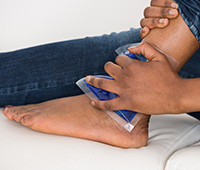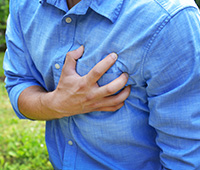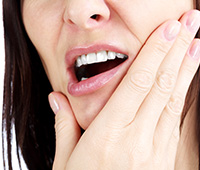WHAT IS Period Pain
- Definition
- Causes
- Symptoms
- Diagnosis
- Ayurvedic Tips
- FAQS
- References
Definition

Painful periods are periods in which a woman has severe throbbing or cramping pain in the lower abdomen that comes and goes, along with back pain in some cases.12Painful periods is medically known as “dysmenorrhea”.3
Many women have painful periods which makes it hard to do normal household work, job, or school-related activities during each menstrual cycle. Painful menstruation is one of the major causes of absenteeism from school and work among women in their teens and 20s.1
Although periods are a normal part of a woman's life, severe period pain need not be. Women do not have to suffer because of it - period pain can be treated with medicines.3
Ayurveda proposes the factor of 'stressful lives' of women in the modern world which is responsible for the development of painful periods or 'Kashtartava'. It further states that the challenges women face in their daily life today results in Mithya Ahar, vihar (improper diet & lifestyle), over-exertion & malnutrition, which causes vikruti (state of disease) in the “Rutuchakra’’ (cycle of nature) leading to various vyadhi (pain and discomfort) in their monthly period.4
Disclaimer: The information on this page is not intended to be a substitute for professional medical advice. Do not use this information to diagnose or ayurvedic treatment of pain and/or period pain without consulting the doctor. Consult your physician before beginning an exercise regime. "While we have products /ayurvedic medicines for pain and/or period pain, you must consult an authorized physician before taking any of the products. For more information on products, visit www.dabur.com or call 1800-103-1644"
Causes
Causes OF Period Pain
Painful periods fall into two groups, depending on the cause:1
- Primary painful periods
- Secondary painful periods
Primary painful periods occur around the time that periods first begin in otherwise healthy young women. In most cases, this pain not related to a specific problem with the womb or other reproductive organs. Increased activity of the hormone prostaglandin, which is produced in the womb, is thought to play a role in this condition.1
Secondary painful periods develop later in women who have had normal periods. It is often linked to problems in the womb or other reproductive organs, such as:1
- Endometriosis - This condition occurs when tissues that generally grow inside the womb grow somewhere else in the female reproductive system, such as on the outside of the womb, eggs, or womb tubes.
- Fibroids - fibrous tissue grows inside the wall of womb which is harmless
- Premenstrual syndrome, or PMS - A group of symptoms that start before the period. It can include emotional and physical symptoms.
- Swelling of reproductive organs
- Infections due to sexual activity
- Stress and worries
In Ayurveda texts, Acharya Charaka has mentioned that diseases of the female reproductive organs like period pain arise out of aggravated Vata. Vata is the responsible factor, though other doshas may only be present as Anubandhi (secondary hindrances) to it. So pain is produced due to vitiation of only vata dosha or in combination with other Doshas.4
Disclaimer: The information on this page is not intended to be a substitute for professional medical advice. Do not use this information to diagnose or ayurvedic treatment of pain and/or period pain without consulting the doctor. Consult your physician before beginning an exercise regime. "While we have products /ayurvedic medicines for pain and/or period pain, you must consult an authorized physician before taking any of the products. For more information on products, visit www.dabur.com or call 1800-103-1644"
Symptoms
Symptoms OF Period Pain
Every month the inner lining of a woman's womb builds up and is then shed again at the end of the period cycle, when menstruation begins - unless she is pregnant. To shed the lining during the monthly period, the womb muscles tighten (contract) and relax in an irregular pattern. This helps the tissue lining the womb to detach and flow out of the body, along with blood, through the neck of the womb (cervix) and the vagina (external reproductive duct opening). Some muscular pain during period is considered normal.3
Most of the times, painful period pain is described with the following symptoms:3
- Mild discomfort in pelvis due to muscle contractions
- Painful cramps
- Pain in the back or legs
- Nausea, vomiting or diarrhea in
- Headache or migraine or general discomfort
- Heavier period flow with intense pain
Disclaimer: The information on this page is not intended to be a substitute for professional medical advice. Do not use this information to diagnose or ayurvedic treatment of pain and/or period pain without consulting the doctor. Consult your physician before beginning an exercise regime. "While we have products /ayurvedic medicines for pain and/or period pain, you must consult an authorized physician before taking any of the products. For more information on products, visit www.dabur.com or call 1800-103-1644"
Diagnosis
Diagnosis OF Period Pain
- Pelvic exam: A pelvic exam (examination of the lower abdomen area) and thorough medical history helps your doctor detect any abnormality in your reproductive organs.
If your doctor suspects that your painful cramps are being caused by some other disorder, he or she may recommend other tests, such as:
- Ultrasound: In this test, sound waves are used to create an image of your uterus, cervix, fallopian tubes and ovaries.
- Imaging tests: A CT scan or magnetic resonance imaging (MRI) provides better details than an ultrasound and can help your doctor diagnose underlying conditions.
- Laparoscopy: A small surgery to diagnose conditions like endometriosis, adhesions, fibroids, egg sacs etc.
Disclaimer: The information on this page is not intended to be a substitute for professional medical advice. Do not use this information to diagnose or ayurvedic treatment of pain and/or period pain without consulting the doctor. Consult your physician before beginning an exercise regime. "While we have products /ayurvedic medicines for pain and/or period pain, you must consult an authorized physician before taking any of the products. For more information on products, visit www.dabur.com or call 1800-103-1644"
Ayurvedic Tips
Ayurvedic Tips Period Pain
Ayurveda can play a significant role in managing period pain by practicing a combination of corrective Ahar (diet), Vihaar (exercise) and Aushadhi (Medicines)4
Diet Recommendations (Aahar)
- Eat healthy, warm and fresh foods
- Eat 5 to 6 small meals
- Have fresh fruits like dark grapes, apples, pomegranates, plums, etc
- Eat more leafy vegetables
- Regularly use ginger in food preparations
- Avoid fatty & sugary foods
- Take supplements like calcium, magnesium, vitamin E, vitamin B6, vitamin B12
Lifestyle changes (Vihar)
Exercise, Yoga and meditation can help to reduce and prevent the severity of many ailments that specifically affect women’s health and give them strength, stability and suppleness.Yoga is also found to have encouraging effects on increasing the pain tolerance in individuals.
A few yogasanas used to relive pain in periods are:




Disclaimer: The information on this page is not intended to be a substitute for professional medical advice. Do not use this information to diagnose or ayurvedic treatment of pain and/or period pain without consulting the doctor. Consult your physician before beginning an exercise regime. "While we have products /ayurvedic medicines for pain and/or period pain, you must consult an authorized physician before taking any of the products. For more information on products, visit www.dabur.com or call 1800-103-1644"
FAQS
FAQS
1. Can Ayurveda treat foot pain?
In Ayurveda, foot care is considered very important since it is known to benefit the entire body and nervous system in a holistic manner. There are certain points in our body called marma or vital points, where our vital energies are concentrated. Feet and ankles also have these vital points, which if not taken care of, can cause problems like chronic pain in the ankles, pain and swelling in feet, etc. Ayurveda can play a significant role in managing ankle pain with a combination of corrective Ahar (diet), Vihar (exercise) and Aushadhi (Medicines) regime.
2. What kind of diet and exercises will be helpful in reducing neck pain?
To reduce neck pain, Ayurveda suggests following diet and exercises:
- Take lots of fruits, green vegetable salads and sprouts.
- Good hydration will help retain neck health.
- Avoid refined foods and junk foods.
- Milk is an important source of Calcium and can help maintain healthy bones.
- Vitamin C in citrus fruits will help the healing process.
- Honey in warm water or herbal teas are good for cleansing the bowels and this will help relieve many backaches that are due to constipation.
Pranayama (breathing exercises) is a powerful way to promote relaxation and a pivotal first step towards relieving muscle tension. Slow, deep breathing & relaxation can stimulate a sense of calmness and cause reduction in pain.
Yoga Asanas are also beneficial in maintaining neck and overall health
- Balasana
- Marjaryasana
- Bhujangasana
3. I have knee pain. What could be the reasons for it?
Knee pain can have different causes. Being overweight puts you at greater risk for knee problems. Overusing your knee can trigger knee problems that cause pain. If you have a history of arthritis (swelling of knee joint), it could also cause knee pain.
Medical conditions that can cause knee pain are
- Arthritis – Rheumatoid arthritis, Osteoarthritis, Gout
- Infection in the knees / knee joint
- Injuries – fracture, dislocation, sprained knees etc.
- Cancer
4. What can I do to reduce my knee pain?
Ayurveda suggests following diet and lifestyle changes to help reduce knee pain.
Include more foods containing
- Pulses: Black gram, green gram
- Vegetables & spices: Onion, garlic, sesame seeds, ginger, radish, ladies finger, pumpkin
- Fruits: pomegranate, mango, grapes
- Oils: Ghee
Ayurveda recommends regular, slow and gentle exercises with adequate rest to knee joints. Regular Pranayama and Yoga Nidra is also recommended.
- Avoid prolonged walking, standing, kneeling and squatting and crossed leg sitting.
- Yoga asanas: Makarasana, Pavanamuktasana, Dhanurasana, Vakrasana
5. I have tingling pain in the legs. Is it sciatica?
Sciatic pain most often occurs on one side of leg or hip. Symptoms of sciatica pain can vary widely as mentioned below:
- Mild tingling
- Dull aching that radiates from buttock to back of whole leg
- Burning sensation
- Inability to move leg when pain becomes severe
The pain often starts slowly and may get worse:
- After standing or sitting
- At night
- When sneezing, coughing, or laughing
6. What diet is effective in reducing the sciatica pain?
A healthy diet for controlling sciatica pain is for balancing Vata dosha and includes:
- Grains: Rice, cooked oatmeal, whole wheat and whole grain breads (toasted)
- Pulses: Yellow split mung beans (green skin removed), whole mung beans, red lentils and tofu
- Vegetables: : Zucchini, asparagus, carrot, beets, sweet potatoes, cucumber, lady finger, parsley, green peas, fennel, spinach in small amounts and cooked coconut. All should be cooked well so they are soft.
- Spices: Cumin, ginger, mustard seeds, ajwain, celery seeds, fenugreek, coriander, bay leaves, basil, saffron, hing (asafoetida), cinnamon, cardamom, cloves, anise, fennel, black pepper (in small amounts)
- Fruits: All ripe, sweet, and juicy fruits. Sweet grapes, banana, melons, plums, cherries, mango, papaya, pomegranate, sweet pineapples, raisins, sweet oranges, dates and figs, avocado, apples and pears.
- Oils: Ghee or organic olive oil
- Sweeteners: Honey, jaggery, date sugar
7. I frequently get gas pain. What food types are good for me?
Following foods are good to help relieve gas pain:
- Grains: Whole wheat thick flat bread or chapati, millet & sorghum bhakri, unpolished rice
- Pulses: Chickpea, Tur dal, Masoor Moong
- Vegetables: Carrots, Radish, Lauki, potatoes, white gourd, spiny gourd, , cucumber, ajwain, guar bean, eggplant, amaranth, cabbage, spinach, coriander seeds and leaves, sweet potatoes, tomatoes, green chillies, lady finger
- Fruits: , pears, papaya, pineapple, pomegranate, oranges, unripe bananas, water chestnut, dry fruits – almonds, walnuts, peanuts, dry dates, apples, grapes etc.
- Oils: Ghee, coconut oil in small quantities
- Ginger, cumin, coriander should be preffered in spices.
8. What is trigeminal neuralgia?
Trigeminal nerve (TN) pain is a nerve condition that causes a stabbing or electric-shock-like pain in parts of the face.
It usually affects one side of the face. Any vibration on your face, even from talking, brushing etc. can set it off. The condition may come and go, disappearing for days or even months. But the longer you have it, the less often it goes away. TN pain usually affects women and people above 50 years of age.
Ayurveda describes 11 types of shiro rogas (headaches), among which trigeminal nerve type of pain is called ‘Ardhavabhedaka’. It happens when aggravated doshas (Vata, Pitta and Kapha) press on the neck and throat producing a powerful burning sensation, out of which comes excruciating pain. This pain ultimately affects the eyes, eyebrows and temples.
9. How can Ayurveda help in relieving stomach pain?
Ayurveda describes a comprehensive approach towards managing stomach pain- the most commonly diagnosed conditions being constipation (Vibandha) and indigestion (Ajirna)
Constipation is used to indicate fewer bowel movements, hard stools, painful defection and feeling of bloating, abdominal pain or incomplete elimination.
Indigestion, on the other hand, is an abnormality that occurs in digesting food or lack of proper digestion resulting in stomach pain, burping or flatulance (abdominal gas).
Ayurveda can play a significant role in managing & preventing different stomach pains by practising a combination of corrective Ahar (diet), Vihar (exercise) and Aushadhi (Medicines) regime
Corrective Ahar for both constipation & indigestion includes:
Grains: Wheat, unpolished rice, barley
- Pulses: Green gram, chickpeas, course corn, Toor dal, moong, masura lentils, Vegetables/Spices: Garlic, Asafetida, long pepper, sunthi (dry ginger), green leafy vegetables, cucumber, bitter gourd, pointed gourd, cabbage, dates, betel nut, turmeric
- Fruits: High fibre fruits such as apples, pears, papaya, grapes, amala, haritaki
- Oils: Ghee
Exercise: Regular exercise, meditation and practice of asanas purifies the blood, improves the appetite, increases the will power and makes the patient physically active. The whole alimentary canal improves and becomes regular.
Yoga Asanas: Vajrasana (after every meal), Kurmasana, Vakrasana, Katichakrasana
Pranayama: Surya anulom viloma, deep relaxation technique
10. What is myofasial pain?
Myofascial pain disorder (MPS) refers to pain and swelling in the body's soft tissues or muscles. Myofascial pain is a long-term, painful condition that affects the connective tissue that cover the muscles. It is considered as a type of muscular pain (fibromyalgia) which happens at specific areas on the body.
Myofascial pain might involve either a single muscle or an entire muscle group. In some cases, the area where you experience the pain might not be where the myofascial pain is generated. The actual location of the injury leads to the development of a trigger point, which in turn causes pain in other areas. This is known as referred pain
Disclaimer: The information on this page is not intended to be a substitute for professional medical advice. Do not use this information to diagnose or ayurvedic treatment of pain and/or period pain without consulting the doctor. Consult your physician before beginning an exercise regime. "While we have products /ayurvedic medicines for pain and/or period pain, you must consult an authorized physician before taking any of the products. For more information on products, visit www.dabur.com or call 1800-103-1644"
References
References
- Painful menstrual periods. MedLine Plus. 2014. [Cited 2016 September 4]. Available at: https://medlineplus.gov/ency/article/003150.htm
- Period Pain: Overview. NIH & Pubmed Health. [Updated 2016 July 1]. [Cited 2016 September 4]. Available at: http://www.ncbi.nlm.nih.gov/pubmedhealth/PMH0072508/
- Patil B, Kamde R, Bhalsing V, Bhati K. Dysmenorrhoea (Kashtartava): An Ayurvedic Perspective. International Journal of Herbal Medicine. 2015;3(3 Part A):33-5.
Disclaimer: The information on this page is not intended to be a substitute for professional medical advice. Do not use this information to diagnose or ayurvedic treatment of pain and/or period pain without consulting the doctor. Consult your physician before beginning an exercise regime. "While we have products /ayurvedic medicines for pain and/or period pain, you must consult an authorized physician before taking any of the products. For more information on products, visit www.dabur.com or call 1800-103-1644"




